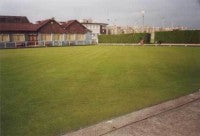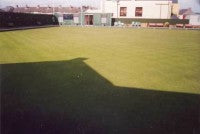Problems on Bowling Green
Problems on our Bowling Green
By Michael Glover
I took over as Groundsman in C.Y.M. Sportsclub in Dublin in l995. Sports include rugby, soccer, tennis and one bowling green (flat). The green is seventy years old and maintenance had been neglected for some time. With increased interest in the section and high membership, maintenance had become important.
The sward comprised mainly Annual Meadow-Grass, some Bent with only a small percentage of Fescue, patches of Yorkshire Fog and on one side of the green patches of Ryegrass. There was a poor rooting system and a thatch problem. The serious thatch was probably caused in part by the overuse of a pop-up irrigation system which, because of prevailing winds and shade from the bar, had given an uneven spread and resulted in parts of the green getting far too much water.
We stopped night time watering using the timer and now water early morning using the pop-ups manually. Selected areas are watered using a hand held hose.
Dry patch was a major problem in the early years and, in spite of regular use of wetting agents, was extremely difficult to control. Eventually, by tackling it at first sight in early spring and spiking the area, putting the hosepipe on it and irrigating to field capacity, we found from then on the response to normal watering or rain was far better.
We began to remove the patches of Yorkshire fog and replaced with cores taken from the green at Autumn renovation. We packed the cores in seed trays filled with sand, and they are ready for use in Spring.
The aeration programme has consisted of hollow coring in the Autumn following on in the winter with chisel tines. We also purchased a set of small 6mm solid tines for the playing season. We have also verti-drained the green with a 13mm diameter tine without any heave to a depth of 200mm.
We have top dressed with sand only at Autumn renovation. One year, because of persistent bad weather, we decided to leave the holes open through the Winter period and top dressed lightly in spring. The green was not affected by this process and, if anything, there was some good new root activity down the old aeration holes.
A soil test showed high phosphate levels, low potassium levels and a pH of 7.0. We fertilised using ammonium sulphate based nitrogen plus potassium and no phosphate. We eventually did supplement with a urea based liquid at the low rate and, as we were having some problems with sward density, we applied monthly applications of iron during the close season.
We scarify as deep as possible with a thatch removal reel at Autumn renovation and use a verti-cutting cassette on the Dennis during the playing season. We did purchase a control wheel for the Sisis but found anything approaching the base of the sward during the summer was guaranteed to cause problems.
We find a cutting height of 5mm during the playing season too slow on the annual Meadow-Grass sward. In good growing conditions from the end of April on, we use a standard 4mm cut and 3.5mm for important fixtures and tournaments. During any stress or drought we raise the blades.
We raised two of the edges on the green and took a chance at the hedge side, as root growth was particularly bad here. We dug out the ditch to depth and removed a lot of roots from the hedge to the green. As we started the sod cutter the old side board started to crumble under the weight but, with one person in front, we managed to strip the sod, we broke up the compaction and used a sand soil mix to level and replaced with new timber. We then used strips of Rye Grass sod on their back at the edge and replaced the existing sod. We top dressed over the winter with a sand/soil mix.

I contacted the STRI and arranged a visit. Ian McClements arrived to inspect the green and discussed the maintenance programme. It was decided to overseed using a 100% Bentgrass mix of 40% Heriot, 40% Lance and 20% Egmont.
The recommendations were for the fertiliser programme to remain the same with a possible reduction in the application rates of the Urea based liquid; the possibility of selectively removing the patches of Ryegrass with a careful spot treatment of total Herbicide; and a suggestion to maintain the winter cutting height at 6mm and to step up mowing frequency during any milder spells of weather to take account of any surplus growth.
We carried out the programme as planned and, because of heavy scarifying before and after coring, applied an Autumn / Winter feed at 50g/m2. Recovery was good and lucky enough no disease until the end of December when we had one attack of Fusarium Patch.
With good growth we cut regularly at 6mm up to the end of December. During January to mid February we just kept an eye on it, and then applied low Nitrogen feed and resumed regular cutting. I was pleased with the results of the overseeding this year and there is some good new Bent showing.
Coping with annual Meadow-Grass on this high usage green over the last seven years has been an interesting experience. Probably, it will be impossible to eliminate it altogether, but if we have some success from the overseeding over the coming seasons we may be able to reduce it.
I believe we have had some success in improving the green during this time. It is in reasonably good condition now and running well.
